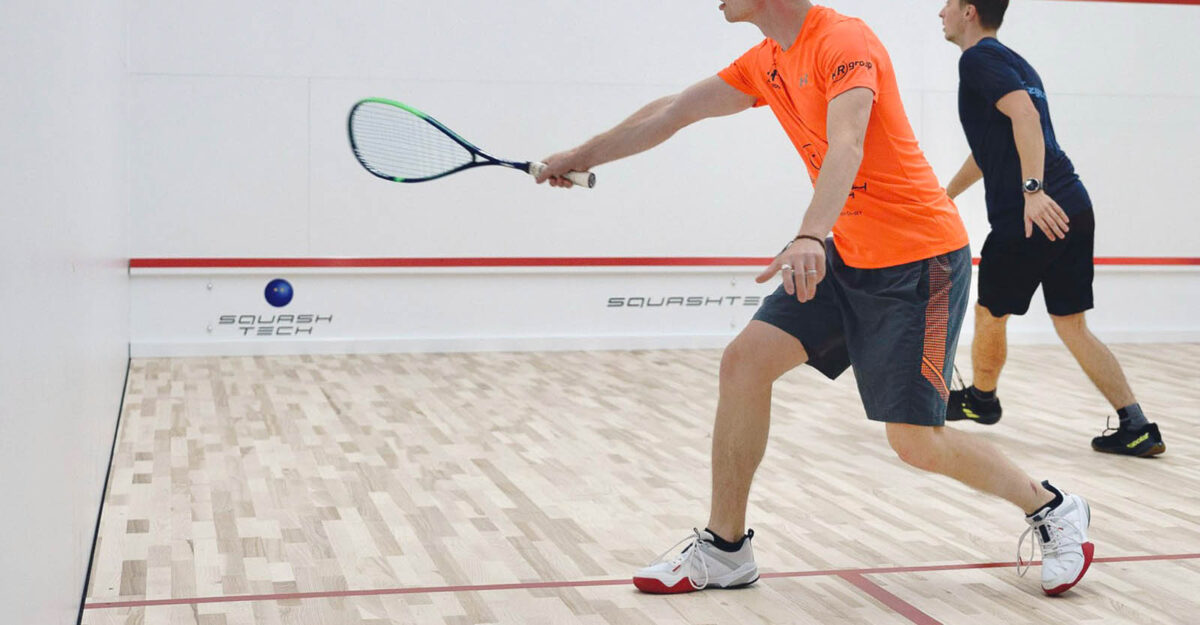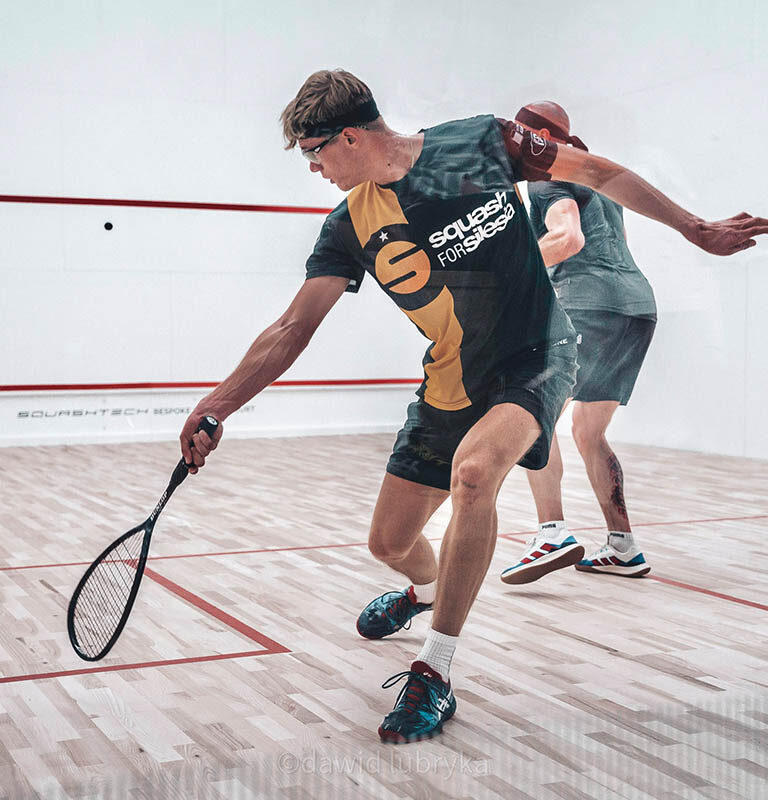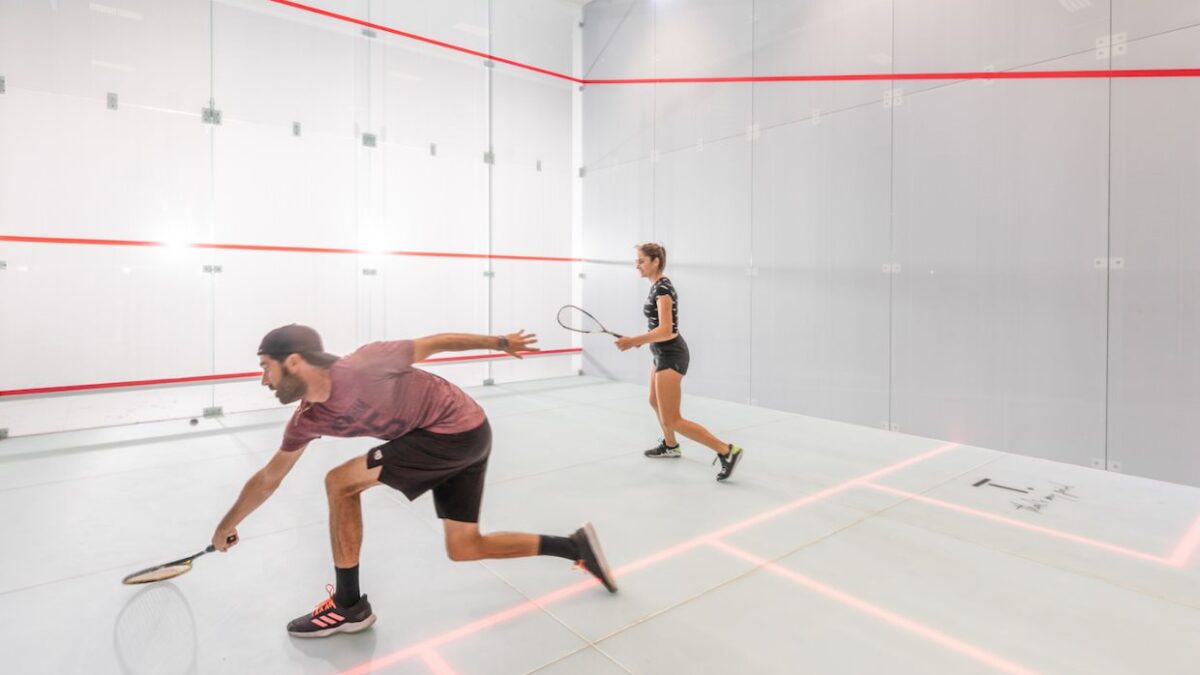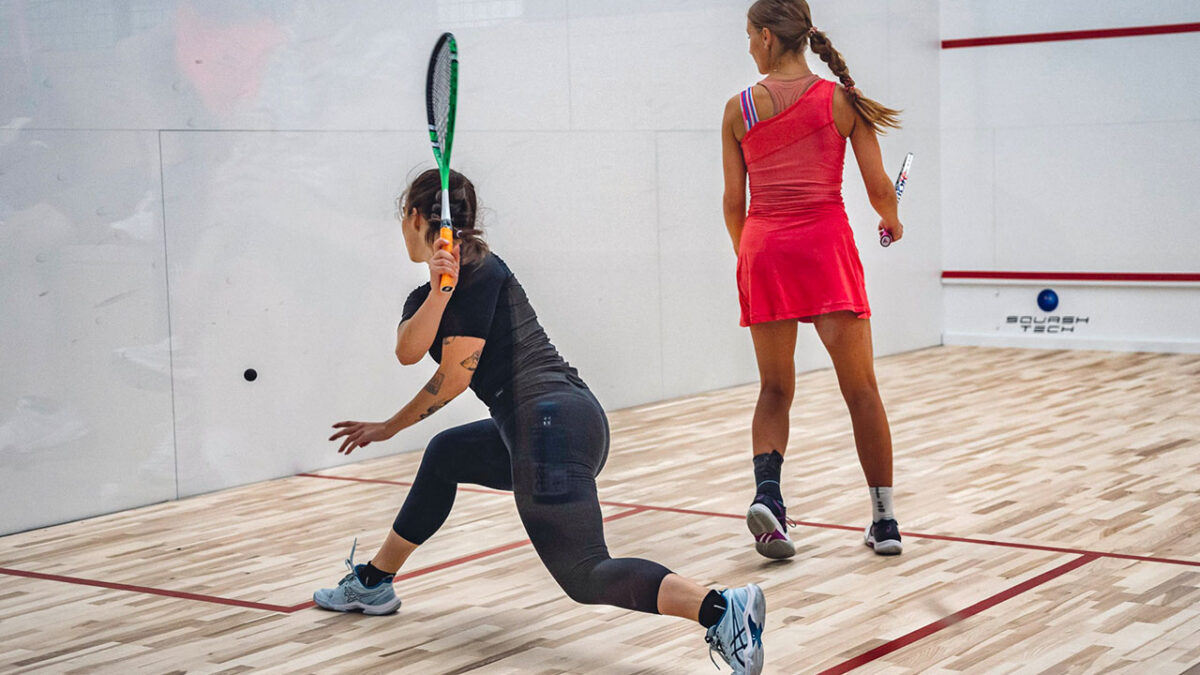


Glass court in Trzyciąż – realization of SQUASHTECH
2025-06-25Squash – rules. How to play to win?
An explosion of dynamics and strategy – a sport that captures the hearts of players around the world with its dynamics and exciting thrill of competition. A sport that is a combination of intense training, great fun and competition. Squash is a challenge for both body and mind that draws you in from the first bounce of the ball. It’s a game where every second on the court matters, and every move can determine victory.
But how do you master the basics and start playing effectively enough to win? In this article you will find comprehensive information on squash rules, strategies and tips to help you improve various skills (you will be surprised how many there are!).
Squash – what is it?
Squash is a dynamic sport played in an enclosed court, where players bounce a ball against the front wall with a racket. The goal of the game is to score points by playing the ball in a way that prevents the opponent from bouncing it, according to the rules. The game requires not only excellent physical fitness, but also strategic skills and quick decision-making. Due to its intensity, squash is considered one of the most physically demanding sports, and its popularity continues to grow around the world.
Rules of squash
The rules of squash may seem complicated at first glance, but they are actually quite easy to master. One set is enough to “get” the rules of squash.
For that, once all the rules are assimilated, smooth play becomes a source of joy and satisfaction. It is worth remembering that training makes perfect!
How to play squash according to the rules? Instructions below!


- Start of the game – the game begins with a serve. The first server is chosen at random before the start of the match, for example, by flipping a coin. The player who wins the draw chooses the side of the court from which he will start the serve. After winning the exchange, the serving player retains the right to serve, while changing the service side. However, if the opponent wins the exchange, the right to serve passes to him. From that point on, points are counted. The serving player must stand in one of the two service zones and bounce the ball so that it hits the front wall above the service line and finally lands in the opposite part of the court.
- Purpose of the game – players take turns bouncing the ball, which must touch the front wall before touching any other surface. The ball can bounce off the side walls, but only once off the floor before bouncing.
Does the ball in squash have to bounce off the ground? No, in squash the ball does not have to bounce off the ground for the play to be correct. A player can bounce the ball both after it bounces off the floor and directly from the air (known as a voley). - How are points counted in squash? – The point is scored by the player who wins the exchange. The game is usually played up to 11 points according to the rules of the “rally scoring system,” which means that a point is scored with every exchange won, regardless of who served. To win a set, a player must score at least 11 points, but the difference must be at least 2 points. In the event of a 10:10 tie, the game continues until there is a two-point advantage. The player who first wins the required number of sets (can be determined between each other) wins – in standard play, the game is played until three sets are won.
In professional tournaments, the match usually consists of five sets, and the winner is the person who first wins three sets. This format is the standard recognized by the World Squash Federation (WSF). Are there breaks in play? – During a squash match there are breaks, but their rules are strictly defined and depend on the rules of the tournament or arrangements between players. Normally, players have a 90-second break between sets.
Mistakes in the game of squash, that is, when you lose a point
If you want to know how to play squash, you also need to know the situations that determine errors on the court – causing the loss of a point:
- Incorrect service – when the ball does not hit the front wall above the service line or does not land in the correct place of the opponent’s service area.
- Hitting at or above the top of the out-of-bounds line – such a play is considered an error and results in the loss of a point.
- Hitting on or below the “blacktop” – the lower part of the front wall is an area out of play.
- The ball hitting the ceiling or the upper net – automatically ends the exchange.
- Ball flying off the court – any play that causes the ball to leave the court costs a point loss.
- Two lobs of the ball on the floor – a player must bounce the ball after the first lob; the second lob marks the end of the exchange.
- Double racket hit – one hit of the ball must be clean; any additional touch is an error.
- Failure to bounce the ball to the front wall – when the played ball fails to reach the front wall, a point is lost.
- Bounce off the floor before reaching the front wall – the ball must bounce off the front wall immediately after being played.
- Covering or blocking the opponent – the so-called stroke awarded to the opponent when you prevent him from rebounding, even though he was prepared to play.
- Ball hitting a player after bouncing off the wall – if the played ball hits the opponent, the opponent scores a point.
LET and STROKE – obstruction on the court
During a game of squash, there may be situations in which a player does not have the opportunity to play the ball through a blocking rival or considers that the hit could be a danger. Then there is a right to report a so-called LET. This is an important element of fair play in squash rules
When to report a LET?
- If the opponent blocks access to the ball or restricts visibility, making it impossible to make a proper play.
- If there is a risk of hitting the opponent with the racket or ball during the swing.
- In any situation where the play could endanger any of the players.
How is a LET reported?
- A LET is reported only by the player who is currently preparing to play the ball.
- The player makes the request verbally.
- The referee makes a decision based on the request and uses hand gestures to announce the result.
Decisions of the judge
- YES LET – the exchange is repeated. The referee shows the sign with his hand – fingers arranged in the shape of the letter “L”. The serving player retains the right to serve from the same side of the court.
- STROKE – a point is awarded to the player declaring a LET if the opponent actually impeded his game or blocked access to the ball. The referee signals this decision by a clenched fist.
- NO LET – the request for a LET is denied and the point is awarded to the opponent. The referee shows an open, horizontally placed hand.
LET is not only an element of the game, but primarily a rule to ensure safety and fairness. The final decision is made by the referee, who must take into account the intentions of the player and the conditions on the court. Remember that reporting a LET is not a sign of weakness – it is part of playing responsibly and professionally. Play fair and always follow the rules, because health and safety are more important than winning!
Improper playing technique
Improper squash technique can not only make the game more difficult, but also make it less enjoyable and more tiring. Incorrect racket grip or poor body position lead to inaccurate strokes, making it difficult to control the ball and force your opponent to run. If, on top of that, you move around the court in a chaotic and inefficient way, you quickly lose energy and start to get tired. To make matters worse, incorrect strokes or improper posture can strain your joints, wrists or shoulders, increasing the risk of injury. As a result, instead of enjoying the game, you can quickly lose motivation.
Safety on the court – play responsibly!
Squash is a dynamic game, so it is not difficult to get injured or have an accident. The most important rule of squash is to take care of your own and your opponent’s safety. Remember to always control your run and swing – hitting your racket too wide or carelessly can end in a painful incident.


How to play squash? Basic rules
- Master the technical basics – learning how to properly serve – forehand and backhand – that is, how to properly hit the ball, is the foundation of successful play. The serve should be precise and powerful, which is a good way to start an exchange with an advantage. Forehand and backhand, the basic strokes, require technique, including proper foot placement, racket grip and the use of strength in the arm. Practicing these plays “dry” and while playing squash is developing one of the most important skills on the court.
- Move efficiently – squash requires quick movement around the court, so footwork is of considerable importance. You should focus on a low body position that allows you to dynamically change the direction of movement. You need to practice moving forward, backward and sideways so that you are always ready to bounce the ball. It’s also a good idea to practice returning to the center position after each stroke – this way you can effectively take control of the game.
- Plan your plays – anticipating your opponent’s movements and planning the trajectory of your strokes is another matter. You should direct the ball to hard-to-reach places – such as the corners of the court – to force your opponent to run. Variety in your plays through low strokes, lobs and strong drives (strikes along the walls), will make it harder for your opponent to anticipate your movements.
Strategies to help you win
- Control of the center of the court – dominating the center of the court gives you an advantage over your opponent, who has to travel greater distances to bounce the ball. Focus on returning quickly to the center after each hit and control the pace of the game, forcing your opponent to defend.
- Playing in the corners – forcing your opponent to run to the corners of the court exhausts him physically, and thus increases your chances of scoring. Aim for hard-to-reach places, and try to anticipate your rival’s movements to effectively block his counterattacking opportunities.
- Variety of plays – use drop shots (the ball lands as close to the front wall and as low to the floor as possible), lobs and drives to surprise your opponent and make it difficult for him to anticipate your moves. Drop shots work great when the opponent is far away, while lobs allow you to gain time to get back inside. Keep your opponent confused by varying the level of force and direction of your strikes.
- Plays used by the opponent – experienced players can use traps, such as apparent plays in one direction, to then quickly change it for the sake of deception. Watch out for balls that appear easy to bounce, but ultimately have a low buck or are directed to the out line. It is important not to be fooled and always be prepared for unexpected twists and turns. Respond with precision and try to take the initiative in the exchange.
Rules of correct service in squash
Position during the serve – the serving player must stand so that at least part of one foot is inside the designated service area. The foot must not touch the boundary lines of this field, as this disqualifies the service.
First hit on the front wall – the ball, when hit, must directly hit the front wall of the court – hitting the side or back wall first during the service is not allowed.
Height of the hit – the ball must hit the front wall above the red service line, but below the top out line. A hit outside these limits is considered an error.
The place where the ball falls – after bouncing off the front wall, the ball should fall to the opposite service area of the opponent, crossing the designated lines on the floor: the transverse and middle lines.
Additional service tricks
- Before touching the service area, the ball can bounce off the side or back walls (after bouncing off the front wall) – a tactical element of the game.
- The opponent can bounce the service directly out of the air (the so-called volley).


Is it possible to play squash alone?
Is it possible to play squash alone? Of course! It is one of the few sports that can be practiced alone. Solo training offers a wide range of opportunities to improve your skills. You can train the serve, aiming at specific points on the wall until the hit is stronger and more precise. Forehand and backhand can be developed by repeatedly bouncing the ball against the wall while maintaining a steady rhythm. Exercises for agility on the court allow you to simulate real exchanges and help you polish your speed and maneuverability. It’s also a good idea to bounce the ball off the wall at different heights and angles, through which you can learn the trajectory of the ball and respond to a variety of plays. Playing squash on your own is an excellent way to build stamina and develop concentration.
Variants of playing squash in more than two people
Squash is not just a one-on-one game! You can try your hand at doubles, where two teams of two players each compete on a wider court, or in a dynamic game of threesomes, where everyone scores on their own account. It’s a varied way to polish your skills and build social bonds.
It’s also possible to experiment with a game of four on a standard court, although this form requires great care in terms of player safety. Different variants of squash make the game even more engaging and provide an opportunity to play with a larger group.


Playing squash – a multitude of benefits
- Building physical fitness – playing squash is an intensive cardio workout that engages the entire body, strengthens the heart and improves the body’s efficiency. It requires dynamic movement, which develops not only endurance, but also improves circulation and increases lung capacity.
- Increasing flexibility and mobility – playing squash regularly increases the range of joint movement and muscle flexibility. Thanks to this, the body becomes more flexible, and the risk of injury in other activities decreases.
- Strengthening muscles – almost all muscle groups work during the game. The greatest strengthening is felt by the muscles of the legs, arms, back and deep muscles responsible for stabilizing the posture.
- Increasing flexibility and mobility – playing squash regularly increases the range of joint movement and muscle flexibility. Thanks to this, the body becomes more flexible, and the risk of injury in other activities decreases.
- Development of strategic skills – the game requires quick decision-making and planning of moves “right away”. Players must analyze the opponent’s moves and almost immediately choose the most appropriate moves. These situations develop strategic thinking, concentration and the ability to react in stressful situations.
- Developing reflexes and coordination – a dynamic match requires immediate reaction to the opponent’s movements and the balls sent by them. The game improves reflexes and motor coordination, which are later used in other activities and everyday life.
- Reducing stress and improving mental health – it has long been known that physical activity helps reduce muscle tension and mental stress. Intensive play releases endorphins, improves mood and lowers cortisol levels. Sport is a great remedy for de-stressing after an intense day and healthy improvement in well-being.
- Building social relationships – playing squash is a great opportunity to meet new people and build relationships. Regular meetings on the court or participating in tournaments promote integration and establishing lasting friendships.
- Burning calories and losing weight – squash is one of the most energy-consuming physical activities. An hour of intensive play can burn up to 700-1000 calories! We already know the way to lose weight in a healthy way. 🙂
SQUASH
Enter the court, grab a racket and feel the emotions that accompany every play. Squash is not only about competition – it is also an option to improve fitness, reduce stress and develop strategic thinking. Every point you score is not only a step towards winning, but also to better health and well-being. Start today, let yourself be carried away by this dynamic game and see how quickly squash can become your sports passion!
Discover the SQUASHTECH offer
If you want to create ideal conditions for playing squash according to the correct rules, invest in professional sports courts from SQUASHTECH. We offer comprehensive solutions – from design, through construction of squash courts, assembly, maintenance, to help in running a club.
Regardless of whether you are an individual customer, owner of a gym, hotel or manage a recreational space, we will adapt our offer to your needs. Contact us and see how we can help you create a place your customers will enjoy.





